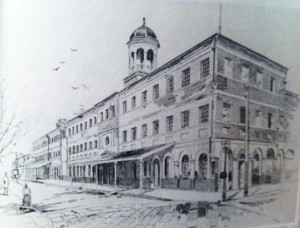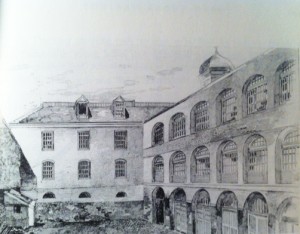To quote one of my old professors who emailed me this week on the topic, “writing narrative is a bitch.”
I think it’s more like a demon from hell. Yea.
While I believe writing in the narrative form to describe real-life events has become more widely accepted in the scholarly community, I still don’t know if it garners the proper respect. And it should! Lordy, it should!
My professor Joel Dinerstein suggested I read Sin in the Second City: Madams, Minsters, Playboys, and the Battle for America’s Soul by Karen Abbott. It is about a famous brothel run by two sisters in Chicago in the early 1900s. I was familiar with the book because my good friend Amanda had given to me a few years back. I just needed to find it on my bookshelf. It was a great recommendation. Take for instance these paragraphs:
Minna navigated the silk couches, the easy chairs, and the grand piano, the statues of Greek goddesses peering through exotic palms, the bronze effigies of Cupid and Psyche, the imported rugs that swallowed footsteps. She had an odd walk, a sort of caterpillar bend and hump, pause and catch up, as the poet Edgar Lee Masters, a friend and frequent client, described it. She came to rest before a wide-paneled window and swallowed, her throat squeezing behind a brooch of diamonds thick as a clenched fist. Holding back the curtain, she surveyed Dearborn Street.
Arc lamps stretched up and out, unfurling bold ribbons of light. The air was thick and yellow, as if the varnish manufacturer on the next block had slathered his product across the sky. Visibility was reduced to the next street, or the next corner, or sometimes just the next step. No matter: Minna didn’t have to see the Levee district to know what it was up to (xxi).
At face value, it’s a lovely couple of paragraphs that really set the scene. When I look at it from a scholarly perspective I think, “that must have been a bitch to write.” To hunt, peck, scrounge, crawl on your belly for details that you then must turn into a dose of nuance – it’s an admirable feat. I can only pray that I spin a few paragraphs like that in my work. As of now, writing about the offices of the Mascot, even in the barest sense, took finding old court documents, having them sit in a dehumidifier for three days, and then painfully going over the handwritten pages for clues.
I have had some serious stumbling blocks this week thus far on Chapter Two in regards to the Mascot’s first libel trial. I wanted some description of the Parish Prison (since the editors of the Mascot eventually spent some time there). I wanted some more personal details on Watson Van Benthuysen, and I wanted some more physical descriptions of Mayor Shakspeare and the city council building. After hours and hours (that add up to days), I have found some information in a variety of sources. But is it enough? Is it ever enough?
The greatest artists/athletes/musicians make it look easy. When they are onstage performing, on the field, or in front of their work, you don’t see the sacrifice, you only see the effortless perfection. Isn’t that what everyone should strive for?
But here is a little something I am leaving you with. Something that will probably not make the book, but in my search, I found this in a typed and bound book from the WPA (Works Progress Administration) from 1939. It is a WPA summary of a series of 1895 newspaper articles (which I found and read – amazing) about the old Parish Prison in New Orleans, on the “gloomy and forbidding” square bounded by Orleans, Marais, St. Ann and Treme:
It is an old legend of the parish prison, reciting how a fiery-headed, pock-marked, worthless old drunken woman hanged herself in a cell, which ever after was visited by her in ghostly counterpart of her former self. Prisoners who were placed in that cell, complained that, at dead of night, some spirit hand pulled their pillows from under their hands, and that on opening their eyes they saw an apparition of a wrinkled, ugly woman glaring at them, with blood-shot, horrible eyes, and inviting by imperious gestures, to hang themselves. The stories were not credited by the prison officials, but after several suicides had happened in that cell, and after many prisoners had made the night hideous, by yells and screams, due to the presence of the supposed ghost, the cell was abandoned.
I have made a willful decision to write my book on the Mascot in a narrative form. More than anything, I want to do this amazing project justice.
I just hope the bitch doesn’t kill me.


